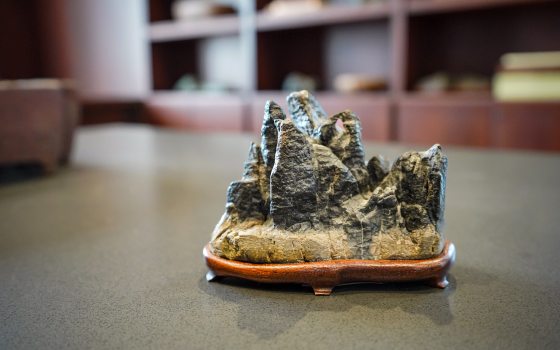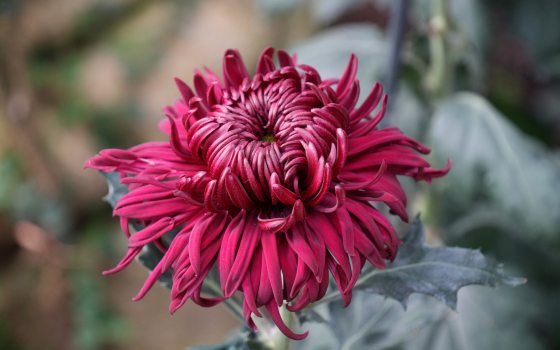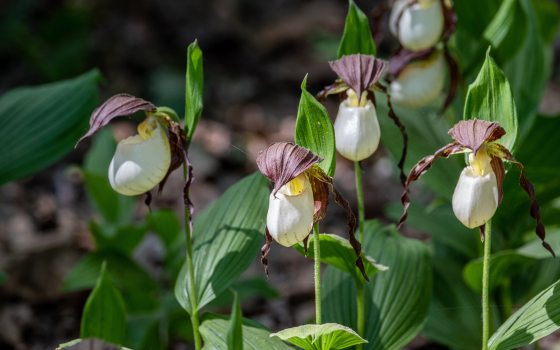Earlier this year, we were delighted to receive a generous donation as multi-faceted and intriguing as it is beautiful. This gift of 42 suiseki stones, given to us by bonsai and suiseki enthusiast Dr. Thomas Goldbaum, not only enhances our existing bonsai collection but also offers an opportunity to share the cultural significance of the fascinating traditional Japanese artform of suiseki. Often referred to as “viewing stones,” suiseki involves the appreciation of naturally occurring stones for their aesthetic qualities and their resemblance to natural landscapes, from mountains to waterfalls, animals to islands. We are honored to steward these pieces and share their artistry—and their story.
Both suiseki and bonsai celebrate nature in miniature forms. While bonsai focuses on cultivating and shaping miniature trees, suiseki emphasizes the appreciation of naturally formed stones—which can be small enough to be held in one’s hands or as large as a carry-on suitcase. Among our collection are those ranging in size from 2.5 inches tall to more than 14 inches tall; those that resemble a near mountain, a distant mountain, huts, plateaus, and figures; and those in colors that range from dark green to red, with glossy to satin finishes. These stones have been collected by many prolific collectors such as Tom Elias, Les Allen, Sean Smith, Seiji Morimae, Jim Greaves, and Melba Tucker.
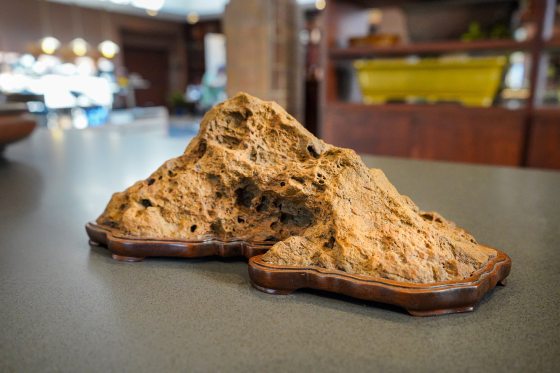
Collected from Chester County, Pennsylvania by Sean Smith, this stone depicts an autumn mountain. Photo by Carol Gross.
Valued for their shape, texture, color, and overall resemblance to a natural scene, each stone is unique and often named after the landscape it resembles. Much like the relationship between a bonsai tree and its container, suiseki stones are carefully displayed on trays or stands to create an image of harmony, and to complement the bonsai with which they’re paired. As such, the art of suiseki involves the collection, preparation, and appreciation of these unaltered, naturally formed stones.
“During a recent visit to Longwood in 2024, I was struck by the depth, variety, and quality of the bonsai collection and how the collection has undergone such a transformation in recent years,” shares Dr. Goldbaum. “It’s exquisite; a truly world-class collection that really spoke to me. I immediately thought about how incorporating suiseki stones into the collection could enhance guests’ experiences even more.”
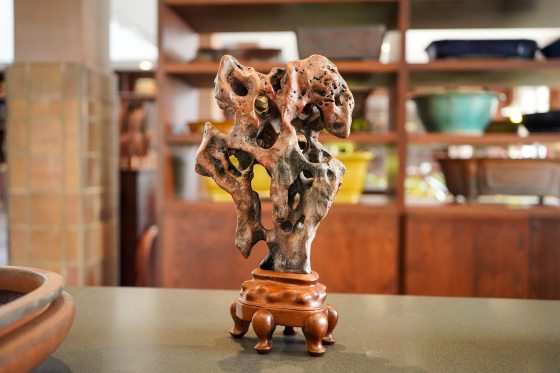
A Lingbi Chinese Scholar Stone from Lingbi County in Anhui Province, China, this stone has been shaped by natural erosion and features unique open shapes—as well as the poetic name “Open Heart.” Photo by Carol Gross.
A cardiologist and yoga practitioner from Maryland who also volunteers at the National Bonsai and Penjing Museum in Washington DC, Dr. Goldbaum first learned about suiseki while in medical school. “I got to know a couple of bonsai and then suiseki enthusiasts during my time in school,” he shares. “From there, I was hooked.”
For Dr. Goldbaum, “bonsai trees require a lot of care and balance that goes into maintaining them. For suiseki, the care goes into finding them.” To be considered a suiseki, a stone must be expressive. It must depict a natural object or scene, naturally formed over time by elements like wind and water. Beyond its form, suiseki are appreciated for color, texture, and surface patterns that enhance its natural appearance and shape. Ultimately, suiseki is meant to provide those engaging with it a connection to nature, to imaginative interpretation, and to contemplation of how it makes them feel.
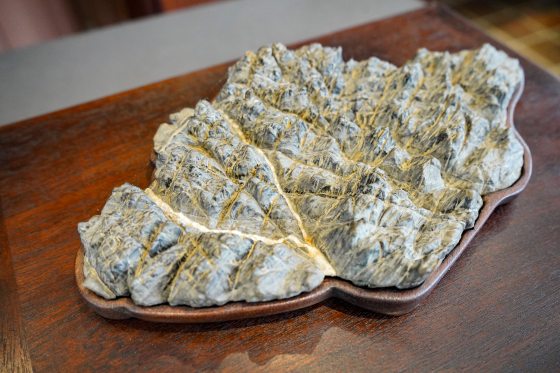
This natural, non-cut stone from Italy resembles multiple river stones. Photo by Carol Gross.
“People have a natural affinity towards stones,” shares Dr. Goldbaum. “Looking at stones involves a level of contemplation, and that level of contemplation can be as in-depth as you’d like. You can sit and contemplate how it makes you feel; how its given landscape or shape can make you feel. If you really explore it, it can bring out a lot of emotion in addition to appreciation for its natural beauty.”
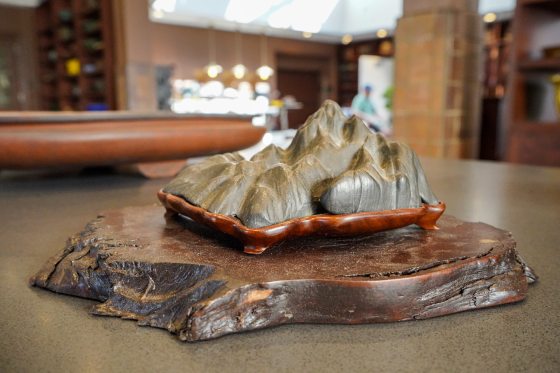
This Japanese natural stone features the poetic name “Graceful Nighttime at the Mountain.” Photo by Carol Gross.
When it comes to collecting, suiseki can be found around the world, with collectors seeking out the stones in their natural environments. Throughout the years, Dr. Goldbaum has made several collecting trips, from lands in Kenya to the oceans around Puerto Rico—and stresses the importance of ethical collection and securing necessary permission to take stones when found.
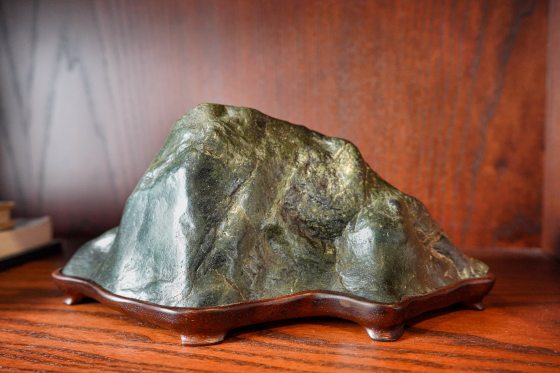
This distant mountain stone from the Eel River in California features a daiza made by Sean Smith. Photo by Carol Gross.
Collectors have different methods and criteria when classifying a suiseki. Classification can be determined by such attributes as a stone’s place of origin, surface pattern, color, or shape, as well as those who have previously owned a given stone or even historical events associated with the stone. Collectors often give a stone a poetic name based on its attributes.
When it comes to display, “Like a piece of artwork that needs a frame to complement it, suiseki need such a container,” shares Dr. Goldbaum. “Balancing the stone with what it’s displayed in is tricky and has to be done just so.” As such, suiseki can be displayed on daizas (custom-made wooden stands), dobans (trays), suibans (pots without drainage holes used for bonsai displaying suiseki in sand), and other stands to enhance their beauty and further illustrate their connection to nature. In addition to the 42 suiseki stones, Dr. Goldbaum also donated to Longwood five suibans, nine stands, dozens of bonsai- and suiseki-related publications, and one driftwood.

This wood base, called a daiza and created by Sean Smith, perfectly complements this natural suiseki stone. Photos by Carol Gross.
We have thoughtfully placed our newly acquired suiseki throughout our historic Bonsai Workshop, paired alongside bonsai containers, objects, and kusamono. We pair the stones with items that harmonize or contrast the feel of one another to enhance the aesthetic, playing off of color, texture, and shape as a way to create small compositional pairings. We rotate the compositions throughout the Bonsai Workshop’s shelves and on our rolling tables, which often feature a new suiseki stone each month.
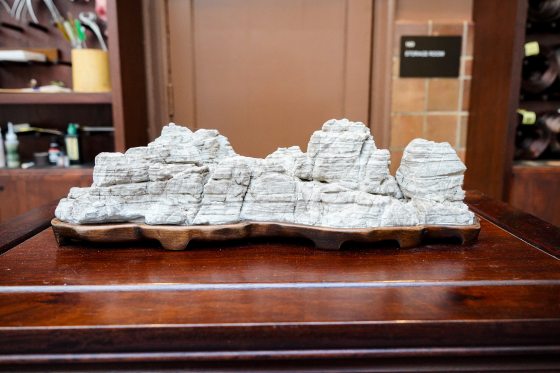
Given the poetic name of “Soft Distant Mountain” and featuring a daiza made by Sean Smith, this Chinese stone resembles the canyons of the southwestern United States. Photo by Carol Gross.
Dr. Goldbaum’s desire to share the beauty and culture of suiseki is remarkable, and his gift to Longwood joins other donations he has made to other cultural organizations across the country. “I truly wanted to find a home for these suiseki stones and a place where others could experience their artform,” shares Dr. Goldbaum. “When you look at Longwood’s mission, education is at the forefront. Then, when you pair Longwood’s commitment to education with the exceptional trees that make up its bonsai collection, as well as the phenomenal Bonsai Courtyard and Bonsai Workshop display areas, all of those factors made this donation an easy decision. I wanted many people to see them, enjoy them, learn about them, and experience them.”
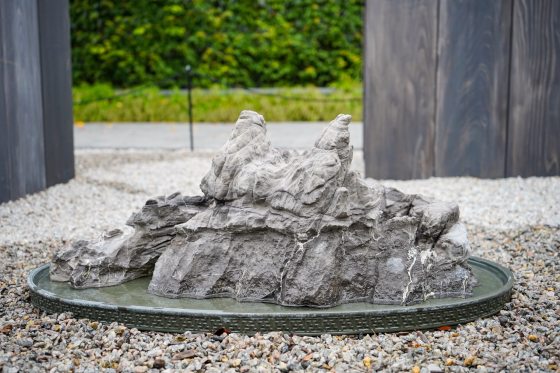
Displayed outdoors on a seasonal basis, this suiseki stone of limestone and with the poetic name of “Old Mountain” was chosen to be outdoors because of its scale and impression in the space; it has a strong presence to balance out our large bonsai specimens. Photo by Carol Gross.
We invite you to take a closer look at our suiseki during your next visit and experience all these stones—and their stories—bring to our bonsai collection.
Editor’s note: Our core collections are supported through gifts, both large and small, each year. Learn more about how you can support our collections.
